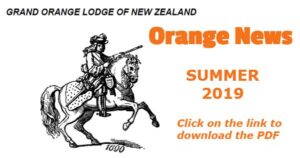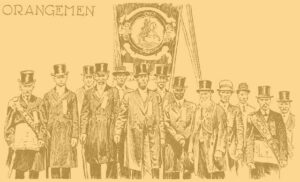1879: The Canterbury Riots
December 26, 2020
By AHNZ
 Today in history, Boxing Day, 26 December, 1879, was a day of violence. In Timaru and Christchurch, the sectarian hatred native to Ireland had transplanted itself all the way to New Zealand.
Today in history, Boxing Day, 26 December, 1879, was a day of violence. In Timaru and Christchurch, the sectarian hatred native to Ireland had transplanted itself all the way to New Zealand.
Vicious sectarian rioting was commonplace between the Catholic and Protestant working class from which new immigrants to New Zealand were drawn in the 1870s. Julius Vogel’s Government blew huge amounts of taxpayer money, and put us into debt too, offering Assisted Immigration in the mid-1870s along with other economic quackery purporting to make New Zealand a stronger economy. New Zealand began to overflow with assisted migrants in quantity and quality it did not need. Vogel simply created, or at least prolonged, the Long Depression (1877-’87) which was a time of misery and despair. New Zealanders who let Vogel play his dangerous game suffered and so did the many new Irishmen enticed and funded into moving to a depressed economy that didn’t want or need them. Another failed State program.
“Certificated scum”- John Hall on the immigrants. Hall became our Premier in October 1879 and soon put his own policy in place. As of 1880 immigrants had to pay £5 in advance, and Assistance was given only to people who had been nominated by those already in New Zealand.
“..the character of the class of immigrants now arriving is a source of very grave anxiety”- Vogel, 1874; Ref. p35 Eldred-Grigg
 In America, particularly New York, the cocktail of agitated Irish set themselves up in weird gang enclaves in ghettos. The weird identitarian sects that resulted and conflicted with one another are documented in the booklet The Gangs of New York: An Informal History of the Underworld (1927.) This was adapted for a 2002 film about the viscous amoral bloodlust between the Irish Catholics and the Irish Protestants. This too had been the result of a State program (eg Tammany Hall.) What happened in Canterbury on the West Coast¹, Timaru, and Christchurch was in parallel to the better known American strife.
In America, particularly New York, the cocktail of agitated Irish set themselves up in weird gang enclaves in ghettos. The weird identitarian sects that resulted and conflicted with one another are documented in the booklet The Gangs of New York: An Informal History of the Underworld (1927.) This was adapted for a 2002 film about the viscous amoral bloodlust between the Irish Catholics and the Irish Protestants. This too had been the result of a State program (eg Tammany Hall.) What happened in Canterbury on the West Coast¹, Timaru, and Christchurch was in parallel to the better known American strife.
Boxing Day Violence
Timaru: A community street procession, a sort of santa parade, was taking place on Boxing Day 1879 and the Orange Lodge (Protestants) resolved to join it. Forewarned, this drew in the Irish Catholics from surrounding districts in preparation to their Orange-garbed foes. This, in turn, drew the Police to quell the growing powder-keg. The riot was defused when the Orangemen agreed to back down.
“Boxing Day, 1879: Irish Catholics vs Irish Protestants riot and fight in New Zealand streets. They are re-creating the conflict from their old country. Many of the instigators were said to be fresh off the boat”- Ref. Disco.
Christchurch: The worst rioting and hurt happened in the less expected place, Christchurch, which had sent 100 of its police south to the Timaru hotspot in anticipation. The Orangemen’s Boxing Day Picnic was soured when they were ambushed by armed Irish Catholics who hid behind Barrett’s hotel..
“The street was suddenly thrown into madness, angry shouts of “Don’t let them pass!” and “Bring down the colours!” filled the air. To the credit of the Orangemen, they attempted to stand their ground, backing away into High Street, beside the Strange’s Department Store.”- DISCO
John Barrett himself was under suspicion as one of, or the, leading Irish Catholic in Canterbury. Barrett was not convicted of any crime himself but his son, Stephen, was and had to be captured and sentenced to 18 months hard labour. Also, I found one reference to one of the Orangemen having to have his arm amputated after the attack (Ref. Evening Star.) By my count, 11 Catholics were found guilty and sentenced to hard labour. One even said he wanted to take over the city of Christchurch!
Why The Hate?
 Some 25% of New Zealanders today can claim Irish ancestry. The Emerald Isle imports didn’t end with Vogel’s Goverment but later agitators such as Michael Joseph Savage, Paddy Webb, and James McCombs were less violent². It seems on the face of it that the Irish Catholics, in particular, had a screw loose and wouldn’t let their Protestant countrymen live and let live. However, it was not as simple as refusing to let some fellow colonists enjoy a Boxing Day walk to a picnic.
Some 25% of New Zealanders today can claim Irish ancestry. The Emerald Isle imports didn’t end with Vogel’s Goverment but later agitators such as Michael Joseph Savage, Paddy Webb, and James McCombs were less violent². It seems on the face of it that the Irish Catholics, in particular, had a screw loose and wouldn’t let their Protestant countrymen live and let live. However, it was not as simple as refusing to let some fellow colonists enjoy a Boxing Day walk to a picnic.
“What do these emblems of a mounted and accoutred warrior with the date 1690, the wearing of weapons of warfare in a public procession by the officers, and Orange insignia and motto betoken? …the parade of them in public Is an outrage of the grossest character to the national and religious sentiments of Irish Catholics, commemorating as they do the defeat of the Irish army at the battle of the Boyne whilst fighting in the cause of the legitimate British monarch, and of their religion, against a Dutch invader, whom this equestrian figure represents. Whilst professing principles of loyalty to the Government, the actions of this society are calculated to foment and perpetuate sentiments of disloyalty in the minds of their Catholic fellow-countrymen. In Ireland these proceedings served a purpose —that of perpetuating class ascendency; but in this free colony assuredly it is not desirable that this feature of old world government should be practically known.”- An Irishman, New Zealand Mail, 1880; Papers Past
 The Northern Irish faction, the Protestent Orangemen, were lording their hegemonic control over their fellow Irish. They were delighted that Ireland and the Catholic King of Britain and Ireland, James II, had been sent packing and taken over by William III’s successful invasion in 1690. Their parades, colours, insignia, and batons were an institutional means of display to rub it in their Catholic countrymen’s faces.
The Northern Irish faction, the Protestent Orangemen, were lording their hegemonic control over their fellow Irish. They were delighted that Ireland and the Catholic King of Britain and Ireland, James II, had been sent packing and taken over by William III’s successful invasion in 1690. Their parades, colours, insignia, and batons were an institutional means of display to rub it in their Catholic countrymen’s faces.
Like an effigy of fallen Catholic Guy Fawkes being re-desecrated every year, or Kaiser Wilhelm’s likeness being twice burned on Mt Eden, the victors were drunk on Identitarianism. They were a Personality Culture, not Individuated enough to have meaning in their own lives that they could let go of the deeds of their ancestral in-group and just be themselves. Men in 1879 were still clinging to 1690 events to draw a line of in-group and out-group even though they were so far in time and space from that connection.
Timaru 1986
Even today there are Irish Catholics whose culture it was, when young, to learn the mocking slander rhymes of their ancestors against Protestants³. It must be that the echos, if not the conscious understanding, of this particular Personality Culture lives on in the descendent of our Irish Immigrants. Especially, the sample of Irish imported by Vogal’s Government. Might there be a connection between Canterbury’s, especially Timaru’s, violent criminality today and their immigrant past?
“The murders of two young men killed execution-style, their bodies dumped at sea on Boxing Day, 1986, was a case that gripped the nation…up the road from Caroline Bay, where they were shot in the back of their heads with a pump-action shotgun.”- Boxing Day Timaru double murder ‘most cold-blooded and sadistic’ seen; Stuff
As an historian on the look-out for connections, I can’t help also noticing another violent Boxing Day outburst in Timaru. This was also a Moral Climate of Honour Culture but the 1980s rather than 1870s.
Frederick Llewellyn Williams and Robin Albert Pope kidnapped and murdered Timaru men Steven Hartley and Paul Wilson on Boxing Day in 1986. Another infamous Timaru Honour Culture outburst, 107 years to the day of the last famous crimes.
It would take a genealogist to know for sure but I suspect all of these men had Irish roots. And, Pope in particular could never be the name of a Protestant family.
“Refugees from Syria are bound for Timaru… in April. “- Stuff (2020)
I think Timaru will probably be well-represented in New Zealand’s next outburst of Honour Culture in the 2020s. Perhaps they will be tempered or inflamed by the hundreds of Syrian refugees being added into their mix. Like the Irish of the past, the Syrians are also at each others throats in a civil war that they’re perfectly capable of bringing with them to New Zealand. Maybe this time the State programme to import other people’s struggles will work out differently though.
—
1 A large population of 1860s Irish immigrants on the Coast also flared up hugely on various occasions
2 Coming later on the Spiral Arm of Moral Culture Cycles, therefore more sophisticated and less primal and violent
3 Eg. Irish Catholics Maggie Barry, Kevin Barry, Peta Mathias etc recollected this for the Here to Stay (2007) doccumentary about NZ immigration
Image ref. Orange Order New Zealand; Facebook
Image ref. Orangemen colourised drawing courtesy of Torontoist – torontoist; DISCO
Ref. THE ORANGE AND THE GREEN RIOT – 26TH DECEMBER 1879; Discover the Delights of Pealing Back History
Ref. 1975: What is a New Zealander?; AHNZ
Ref. A New History of Canterbury; Stevan eldred-Grigg (1982)
2 thoughts on "1879: The Canterbury Riots"
Leave a Reply
 Like Comment Share
Like Comment Share






The urge to fight and remain free is compelling.
Bill the butcher was cast as the bad guy, but has become the hero, against the empty de caprio, whom was doing the oligarchs bidding.
Why were the Irish catholic’s buried in segregated plots in small town New Zealand. Strange. It seems the Catholics were at the back of the bus, fighting the entrenched power.
Divide and conquer probably. The English invaded and subjugated most nations. Irish fighting Irish would suit the Crown.
The fighting spirit needs be redirected. At the oligarchs. Media,, Hollywood, govt, elite, corporations. Unless you identify the enemy, Irish rage is wasted.
Yes, they were buried in segregated plots in small town Canterbury. Surplus stock that Vogel brought in, probably for the same reason Labour 6.0 are doing it now. I can guess Vogel was doing someone (The Empire?) a political favour the same way the United Nations will be glad to have agitated civil war refugees given a new place to go now. ‘Clipping the ticket’ in doing so. Also, creates a vote plantation for the Liberals to the detriment of their political foes: John Hall and William Rolleston of Canterbury (who put a stop to it when they came to power.)
By studying the history perhaps we can redirect the fight to the proper enemy. That’s my plan.